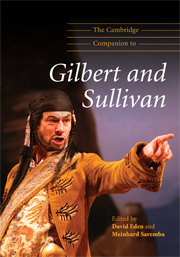Book contents
- Frontmatter
- Part I Background
- Part II Focus
- Part III Reception
- Part IV Into the twenty-first century
- Appendix 1 Who wrote the overtures?
- Appendix 2 Stage and choral works by Arthur Sullivan and W. S. Gilbert
- Appendix 3 Modern editions of works by Arthur Sullivan and W. S. Gilbert
- Appendix 4 Sullivan's archetypes of English opera
- Notes
- Bibliography and further reading
- Index
- Plate section
Appendix 1 - Who wrote the overtures?
Published online by Cambridge University Press: 28 September 2011
- Frontmatter
- Part I Background
- Part II Focus
- Part III Reception
- Part IV Into the twenty-first century
- Appendix 1 Who wrote the overtures?
- Appendix 2 Stage and choral works by Arthur Sullivan and W. S. Gilbert
- Appendix 3 Modern editions of works by Arthur Sullivan and W. S. Gilbert
- Appendix 4 Sullivan's archetypes of English opera
- Notes
- Bibliography and further reading
- Index
- Plate section
Summary
Not all Sullivan’s operas have overtures. Victorian audiences showed little regard for these orchestral preludes, chatting over and generally paying little attention to them. Sometimes, therefore, when time was short, Sullivan delegated the task of arranging an overture from the music of the opera to others. In some – possibly all – cases he set out his structural and thematic requirements and usually made some alterations to his assistants’ work.
For a long time, the question of authorship of several overtures remained unresolved and a number of incorrect attributions were widely accepted. Roger Harris went a good way towards producing a definitive list and my own later researches finally settled the issue in the case of the works marked ∗.
Overtures by Sullivan: The Sapphire Necklace, Cox and Box, Iolanthe, Princess Ida, The Yeomen of the Guard, The Gondoliers, Utopia Limited, The Grand Duke. The overture to Thespis is lost. Because, thematically, it seems to have been significantly independent of the opera, it is likely to have been Sullivan’s own work.
Alfred Cellier arranged the overtures to HMS Pinafore and The Pirates of Penzance, and Eugene D’Albert the overture to Patience∗. Hamilton Clarke was responsible for the overtures to The Mikado, Ruddigore and The Sorcerer∗ – the last having been written for the 1884 revival to replace the ‘Graceful Dance’ from Sullivan’s Henry VIII music pressed into service for the original production.
David Rusell Hulme
- Type
- Chapter
- Information
- Publisher: Cambridge University PressPrint publication year: 2009



